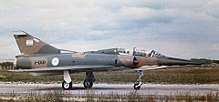8th Air Brigade (Argentina)
The 8th Air Brigade was an Argentine Air Force brigade that existed between 1976 and 1988 based on Mariano Moreno airport near Buenos Aires. It was created upon the procurement of Mirage III fighters planes and fought during the Falklands War.
| 8th Air Brigade | |
|---|---|
| VIII Brigada Aérea | |
| Active | 5 January 1976 |
| Disbanded | 7 March 1988 |
| Country | |
| Branch | Argentine Air Force |
| Type | Military aviation |
| Role | Fighter |
| Garrison/HQ | José C. Paz, Buenos Aires |
| Engagements | Falklands War |
| Commanders | |
| Notable commanders | Atilio Triulzi C. A. Corino |
| Insignia | |
| Identification symbol |  |
| Aircraft flown | |
| Interceptor | Dassault Mirage IIIEA (10) Dassault Mirage IIIDA (2)[1] |
History
In the early 1960s, the Argentine Air Force began an analysis of the requirements needed to replace the Gloster Meteor and complement the F-86 Sabre. In 1967, a pre-contract was signed with aircraft manufacturer Dassault Aviation which was formalized on July 14, 1970. The contract specified the purchase of 10 single-seater Mirage III aircraft and two two-seater aircraft. The headquarters of the Official Civil Aviation Base were selected in José C. Paz, a province of Buenos Aires, to receive the new units. The new unit, initially called Mariano Moreno Squadron and commanded by Vice Commodore Atilio Triulzi, would receive its first two aircraft (I-001 and I-003) in September 1972. Initially, Vice-mayor David Giosa and Captain Mario Román were selected for flight training in France.
Towards the end of 1971, two commissions (operational and technical) were appointed whose personnel would receive training in the new weapons system.
On September 21, 1973, the directive order 90/73 established the Military Air Base Mariano Moreno, seat of the 1st Fighter-Interceptor Squadron. The importance of the unit as an element of air defense culminated in the creation of the 8th (VIII) Air Brigade on January 5, 1976, in addition to 8th Operations Group, which was later named 8th Fighter Group.[2]
In 1988, due to reorganization of the Air Force, it was decided to concentrate fighters of the same family in the same air units. This meant the dissolution of the 8th Fighter Group ordering the transfer of their aircraft to the 6th Fighter Group with seats in Tandil. The transfer concluded on March 7, 1988, the day in which the VIII Air Brigade was deactivated, with the Mirage III being integrated into the 2nd Squadron of the 6th Group.
Falklands War

In April 1982, after the Argentine landings in the Malvinas (Falklands) and escalation into war with the United Kingdom, G8C was deployed to Patagonia, concentrating the Mirage Squadrons at the bases of Comodoro Rivadavia and Rio Gallegos.[1] They were to defend the mainland against possible British attacks, by long-range Avro Vulcan bombers and carrier-borne Sea Harriers. The Mirages were armed with two R-550 air-to-air missiles, one R-530 and two additional fuel tanks.
On May 1, 1982, British aircraft attacked vital positions on the islands with formations of Sea Harriers and Vulcans. In its first operation of the day, the Rio Gallegos squadron deployed five Mirages, in two formations. One formation, while escorting A-4B Skyhawks, made contact with a Sea Harrier, but all of the aircraft involved returned to base without significant damage. The other formation closed on British aircraft, although neither side made contact and the Mirages returned to base. During the last deployment of the day, two Mirages were directed towards British bases on Soledad Island; after attacking these, one of the Mirages was shot down by an AIM-9L. The pilot of the second Mirage was killed when critically low on fuel, he attempted to land at Puerto Argentino (Port Stanley), and was accidentally shot down by Argentine anti-aircraft gunners, who mistook the Mirage for a British plane.
After May 1, G8C was ordered to avoid British fighters and was instead dedicated to air defense over the mainland and diversion operations, until the end of the conflict. One of the Mirage diversion flights, on June 8, successfully lured away Sea Harriers on patrol, allowing an A-4B to destroy two Royal Navy landing craft at Pleasant Bay.
The last mission of G8C took place on the last day of the conflict, when two Mirages escorted two Canberra as they bombed British forces near Mount Kent. During the conflict, the Mirages carried out a total of 56 combat missions.
Pilots
| Service record | |
|---|---|
| Part of | South Air Force |
| Commanders |
Major H. Paez Major J. Sánchez |
| Operations | 56 missions |
Source[3]
- Major José Sánchez.
- Major Luna.
- Captain G. Ballesteros.
- Captain G. A. García Cuerva (dead).
- Captain Ricardo González.
- Captain Raúl Gambandé.
- Captain Carlos Arnau.
- Captain Marcos Czerwinski.
- Captain Jorge Huck.
- 1st Lieutenant Perona.
- 1st Lieutenant Yebra.
- 1st Lieutenant Marcelo Puig.
- 1st Lieutenant Carlos Selles.
- 1st Lieutenant Alberto Maggi.
- 1st Lieutenant Bosich.
Order of battle
- 8th Air Brigade.
- 8th Fighter Group.
- 8th Technical Group.
- 8th Base Group.
References
- Alejandro Golpe. "Avions Marcel Dassault Mirage III". AMILARG (in Spanish). Retrieved 5 June 2018.
- Santini, Luis (4 September 2012). "40 years of the Mirage in Argentina". 3040100 (in Spanish). Retrieved 5 June 2018.
- Santini, Luis (19 April 2012). "8th Fighter Group – Mirage III". 3040100 (in Spanish). Retrieved 5 June 2018.